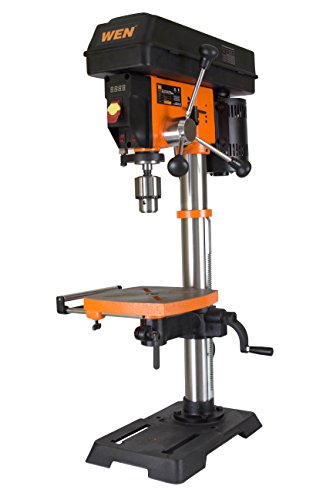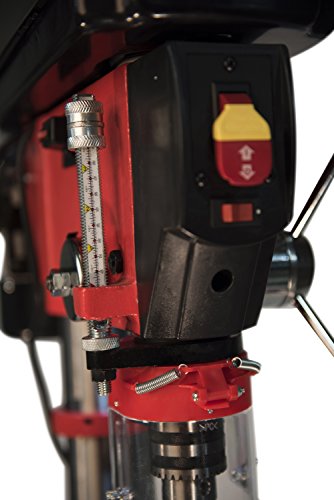
There is hardly any handyman that doesn’t have a handheld drill or an impact driver in his toolkit. Drill presses are, on the other hand rare. One of the main reasons is that they are stationary tools – they are not meant to be taken around different job sites.
If you tend to do a lot of work in your workshop, though – whether with wood or metal – getting a drill press (an potentially a mill) will definitely save you a lot of time over the long term.
Continue reading to learn what it actually is, why you would want to use it, and what exactly can be done with it.
What Is a Drill Press?
 A drill press is a popular tool used by woodworkers and metalworkers for precision work. It typically consists of a drill head mounted on a column which can, in turn, be fixed on some immovable object like a workbench. Standalone floor drill presses also exist. In either case, unlike a hand drill, a drill press is not meant to be moved around or taken to a worksite.
A drill press is a popular tool used by woodworkers and metalworkers for precision work. It typically consists of a drill head mounted on a column which can, in turn, be fixed on some immovable object like a workbench. Standalone floor drill presses also exist. In either case, unlike a hand drill, a drill press is not meant to be moved around or taken to a worksite.
The drill head can be moved up and down the column as required. Since the drill axis is fixed and does not deviate due to jerks like it does when using a handheld drill, it can deliver a very precise cut or bore into the intended object.
To learn more about drill press, read my guide to its parts and their functions.
Why Use a Drill Press?
There are several reasons why a craftsman would prefer a drill press to a handheld drill. Some of the main ones include the five below.
1. Accuracy
A drill press is much more accurate than a handheld drill, even with measures taken to drill straight.
While you can make holes in wood with a standard handheld drill just as easily, it’s almost impossible to make identical holes or holes lined up perfectly. A drill press allows fine control and precision for the depth, angle, and width of each hole.
The tool lets you make identical holes in a matter of seconds.
2. Speed
It’s not just accuracy that improves with a drill press, you can also work faster and more efficiently. Since the drill press ensures uniformity of size, angle, and depth, you don’t have to be as careful while drilling as you have to be when using a handheld tool.
Since drill presses are highly automated and have bigger motors than handheld models, the bits rotate faster and create holes quicker as well.
3. Power
With its large motor, a drill press can accommodate larger drill bits, letting you make bigger and deeper holes than those possible with handheld tools.
In addition, you can use a lever to control the chuck and spindle to make holes easily. The volume of work you can execute in a given time goes up drastically. Thanks to the drill press, you can complete projects in a timely fashion with less effort.
4. Versatility
Besides letting you work faster and more efficiently, drill presses offer new options for woodworking, such as drilling holes in unbalanced wooden pieces like furniture legs or drilling at precise angles.
Separately, a drill press can do much more than just drilling holes. You can use it for tapping or reaming a hole among other things. You can use a mortising attachment to make square- and rectangle-shaped holes. You can change the speed of the motor and fit tools and attachments like a rotary sanding disc or a spindle sander into the tool as well.
5. Safety
Finally, drill presses are safer than conventional handheld drills.
On many models, you can adjust the speed of the tip precisely and fully control the math and options of the drill bit, lessening the chances of something going wrong.
4 Common Uses of a Drill Press
Now that you’ve seen what the advantages of a drill press are, let’s look at some of its common applications.
1. Drilling
First and foremost, of course, a drill’s job is to drill holes.
Drill presses take this a step further by cutting precision holes of the same exact size, angle, depth and width, all thanks to the drill’s fixed head in combination with the adjustable table.
You can fine-tune a drill press, and vary the rotating speed as needed. Keep in mind that the drill’s speed of rotation should be lowered when increasing the drill size. If drilling holes in metal, a more powerful motor and upgraded parts for your drill press might be required.
2. Deburring
Once a hole has been drilled, it often needs to be deburred.
Sometimes, the top side of the hole may be clear, but the bottom may still have some burrs. A drill press with a deburring tool attached will make doing this task a breeze.
3. Reaming
A reamer must be used in cases where a hole has to have a precision of more than 1/2000-inch in diameter. In such cases, drill the hole a little smaller than actually needed, then drive a reamer down with a constant and slow speed to achieve the precise result.
4. Tapping
Some crafting jobs require cutting threads into a hole, and a drill press is ideally suited for this task. The taps and dies are very brittle and require a lot of precision and measurements so that the threading keeps its alignment.
Summary
Drill presses are, in essence, drills mounted on a frame that allows them to move up and down along a fixed axis. While the concept is simple, it allows for a lot of precision in cutting holes. It will ensure that your holes are perfectly straight and that each hole you drill is exactly the same. (I talk about how to use a drill press in this article.)
Besides that, the tool can not only be used for drilling holes, but also for deburring, reaming, and tapping them among other things. For each of those things, you will – of course – need a different bit.
As such, if you are an aspiring woodworker or do a lot of projects that require straight holes – or drilling into uneven objects – you will definitely want to consider getting yourself a drill press. While they are more expensive than regular handheld drills, they will also save you a lot of time.


